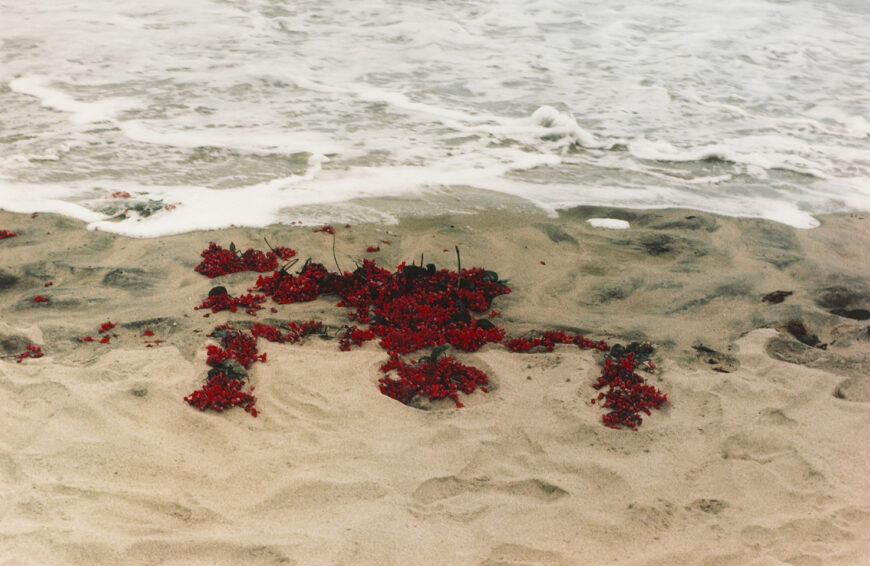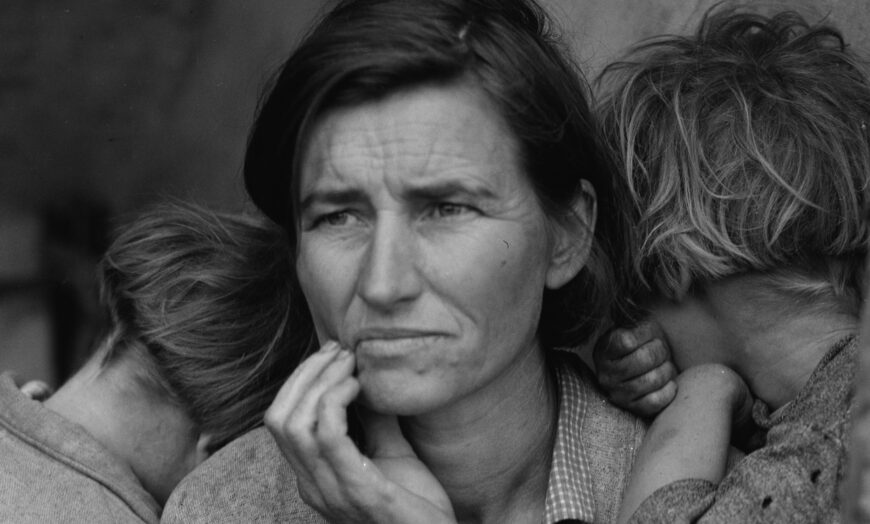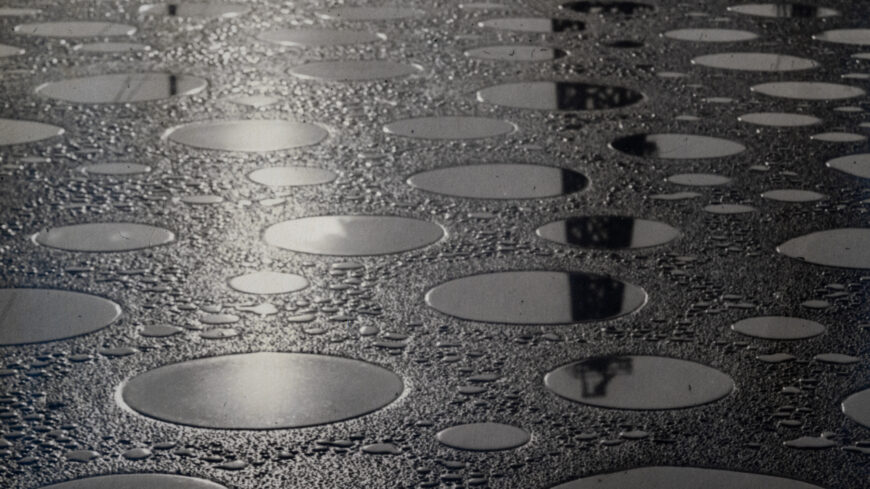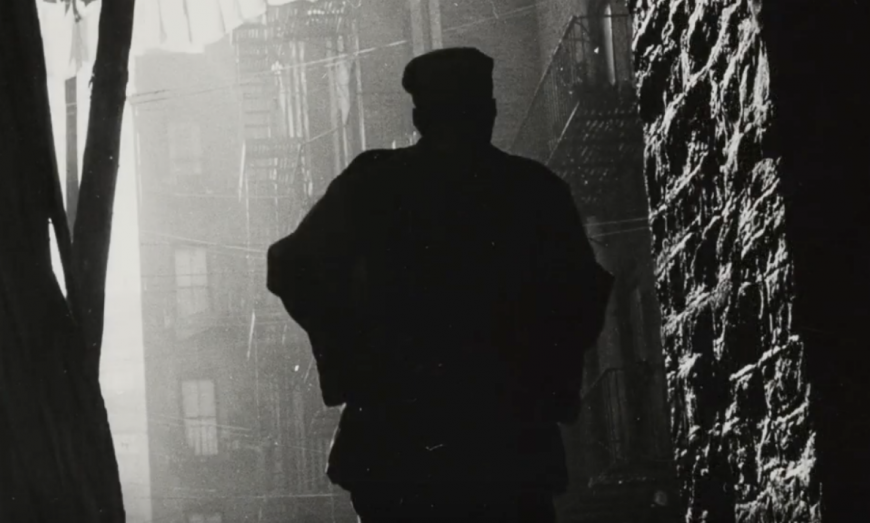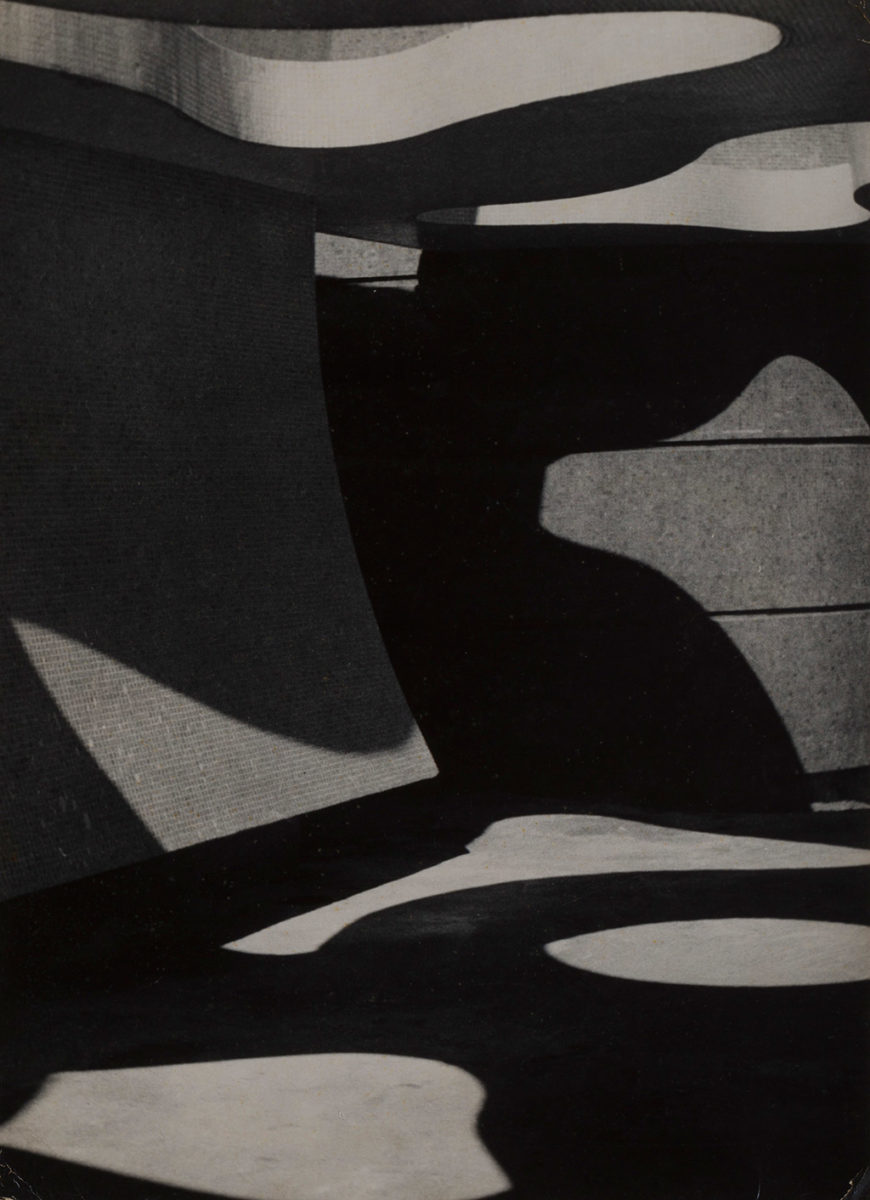
José Yalenti, Architecture or Twilight, c. 1957, gelatin silver print (Museu de Arte de São Paulo)
At first glance, José Yalenti’s Architecture or Twilight seems like a disorienting jumble of splotches of inky black spilling over medium-grey surfaces, cut through by startlingly straight lines and a variety of surface textures. The photographer’s descriptive title orients us, and three-dimensional space emerges from the chaotic greyscale forms. We are looking at the shadows cast by the perforated cement canopy of a covered walkway. Organically shaped marquees like these were a popular feature of mid-century Latin American architecture, which favored permeable indoor/outdoor spaces well-suited to a tropical climate like Brazil’s. The best example of a structure like this is the canopy Oscar Niemeyer designed in 1954 as the centerpiece for a complex of buildings in Ibirapuera Park in São Paulo.

Werner Haberkorn, View of the Ibirapuera Marquee, c. 1954, gelatin silver print (Museu Paulista (USP) Collection)
Recognizing the photograph’s subject allows us to see how the picture engages two important media that were intertwined in 1950s Brazil: architecture and photography. The year 1939, eighteen years before Yalenti created Architecture or Twilight, was a pivotal year for both architecture and photography.
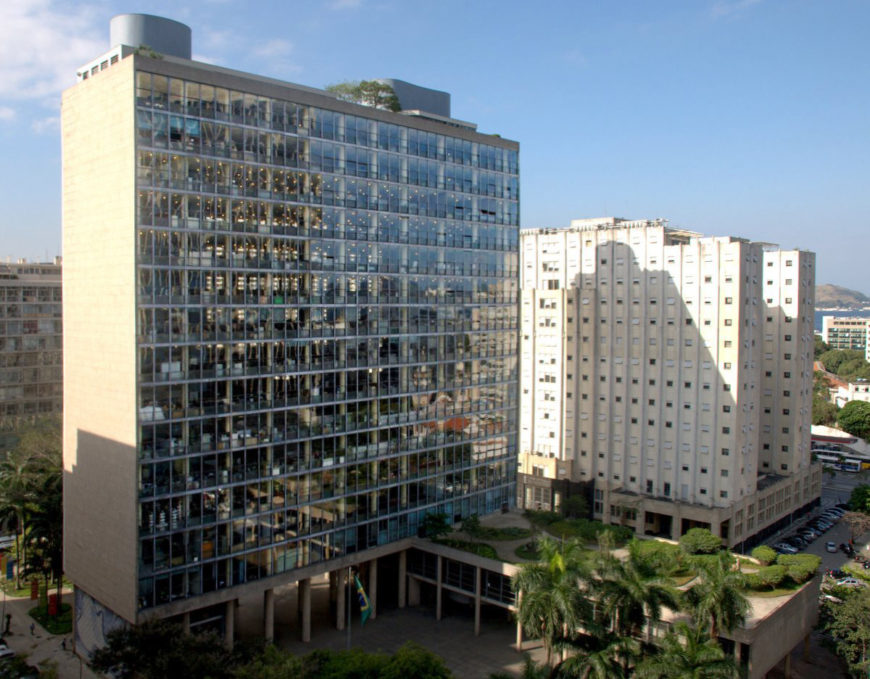
Lucio Costa, Affonso Eduardo Reidy, Oscar Niemeyer, et al. Ministry of Education and Health Building, Rio de Janeiro, designed 1935-36, constructed 1939–43 (source)
It was the year work began on the iconic Ministry of Education and Health Building (MES) in Rio de Janeiro—the project which most scholars consider the beginning of Brazilian architectural Modernism—and the year that Yalenti, along with colleagues Eduardo Salvatore and Benedito Duarte, established the Foto Cine Clube Bandeirante (FCCB) in São Paulo, the group that did the most to codify the language of Brazilian Modern photography. These events are foundational to the creation of Architecture or Twilight, and to the development of Brazilian Modern art, which became increasingly abstract between 1939 and 1957.
Photography in São Paulo

José Campos do Amaral and Raul Silveira Simões, Martinelli Building, São Paulo, Brazil, completed 1929
José Yalenti was born in São Paulo, Brazil in 1895, and came of age during a spectacular population boom. Between 1930 and 1955, São Paulo’s population nearly quadrupled from 550,000 people to two million. Immigrants fleeing war-torn Europe (like Yalenti’s Italian parents) and rural Brazilians looking for better jobs fueled São Paulo’s expansion. As the population grew, so did its infrastructure: magazines boasted that Paulistanos (inhabitants of the city), built three new homes every hour. [1] After the inauguration of São Paulo’s first skyscraper, the Martinelli Building in 1929, high rises began springing up.
On April 28, 1939, a group of photography aficionados, including Yalenti, formed the Foto Clube Bandeirante, later changed to Foto Cine Clube Bandeirante, or FCCB. Like many members of the FCCB, Yalenti was an amateur photographer who practiced as a hobby. The FCCB hosted photography seminars, weekend excursions, and internal competitions. They also housed a library and darkroom for members’ use. FCCB was open to both men and women, but yearly dues made it primarily accessible to members of São Paulo’s upper-middle class.
Starting in the late 1940s, a contingent of FCCB photographers began creating photographs of abstracted architectural motifs (as in Architecture or Twilight), and eventually became known as the Escola Paulista, or “Paulista School.”
Modern Architecture and Photography
Yalenti was among the members of the unofficial Paulista School. Between 1945 and 1960, the Paulista School photographers explored the rapidly changing formal qualities of São Paulo. By photographing skyscrapers and stairways at steep angles, creating closely cropped compositions from found geometric motifs, and capturing the flattening effects of shadows, Paulista School photographers investigated the new physical perspectives emerging in the urban environment. They created a distinctively Modern aesthetic that used strong contrasts of light and dark, geometric forms, linear compositions, and collapsed space to assert photography’s status as an artistic medium.
As part of their pursuit of photographic Modernism, Yalenti and his fellow Brazilians adapted the stylistic innovations of U.S. and European photographers such as f/64, New Objectivity, Dada, Surrealism, and the Bauhaus, to the Brazilian context. Along with his FCCB compatriots—Thomaz Farkas, Geraldo de Barros, and German Lorca, among others—Yalenti explored the formal properties of black-and-white image-making.

Thomaz Farkas, Side view of the Ministry of Health and Education, c. 1948, gelatin silver print, 32.6 × 29.9 cm (MoMA)
Yalenti and the Paulista’s School’s abstract photographs responded to the new trends in Brazilian Modernist architecture being developed by young architects in São Paulo and Rio de Janeiro. In 1939, Lúcio Costa, Oscar Niemeyer, and Affonso Reidy broke ground on the Ministry of Education and Health Building (MES), the building that would define Brazilian architectural modernism. The Rio-based team combined elements of Le Corbusier’s undecorated structural purity with Brazilian regional design to produce a more organic and “tropical” Modernism that responded to the local culture and climate. [2]
The sinuous and sensuous curves of Yalenti’s photograph are directly influenced by stylistic developments in architecture at the MES, including the building’s covered entry and its organically abstract contours. By 1957, when Yalenti created Architecture or Twilight, Brazil was globally recognized as an architectural leader. MoMA in New York City organized a popular exhibition of Brazilian architecture in 1943 (“Brazil Builds”), and highlighted the country again in its survey show “Latin American Architecture since 1945,” that ran from 1955–56. Brazilian photography was also recognized internationally when the FCCB was invited to join the influential FIAP (International Federation of Photographic Arts) as its first non-European member in 1950. Thus, Architecture or Twilight capitalizes on the global reputations of Brazilian architecture and photography.
The Language of Lines
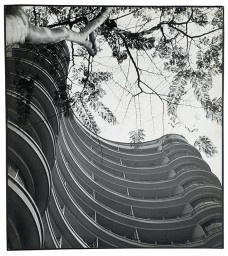
José Yalenti, “Reverse,” published in “A Linguagem das Linhas,” Íris vol. 2, no. 15 (April 1948), p. 21.
Yalenti studied civil engineering at the Escola Politécnica da Universidade de São Paulo (Poli-USP), one of Brazil’s most prestigious universities, and the training ground for many important mid-century Brazilian architects and city planners. During the time he frequented the FCCB, Yalenti also worked as an engineer for the São Paulo city government, so he was aware of the changes taking place in his city and of modern architectural trends throughout Brazil. In 1948 Yalenti wrote an article for a Brazilian photography magazine Íris titled “The Language of Lines,” in which he argued that to consider photography a fine art, practitioners must embrace the medium’s inherently graphic qualities, specifically the way it speaks through lines. [3]
In the Íris article, Yalenti identified five types of lines—“parallel and diagonal,” “arabesques,” “circular,” “triangular,” and “reverse”—and provided examples of each type from his own photographs. Although Yalenti did not clearly define the characteristics of each type of line, four of his sample illustrations were photographs of buildings. Yalenti felt that the linear quality of architecture was rendered particularly emphatic by the black-and-white film (color film was prohibitively expensive in Brazil at the time). As he wrote:
The language of lines is the domain of photography, an indisputable and exclusive domain, and not even the most celebrated painters of all history have been able to create with their artworks equal [to photography]. [4]
Although written almost a decade before Architecture or Twilight’s creation, Yalenti’s musings in Íris help us to understand what the photographer saw in the photograph’s jumble of lines and patches of grey: it is a visual treatise on seeking out new perspectives and “writing with light”—as the word “photography” implies. For Yalenti, black-and-white photography most directly responded to the changes he saw in São Paulo’s physical and artistic environment as industrialization and a new architectural language swept the city. Architecture or Twilight demonstrates Yalenti’s commitment to creating artistic photographs using a linear, abstract, formal vocabulary that drew from contemporary architectural trends and reflected the rapid growth of modern Brazilian cities.



